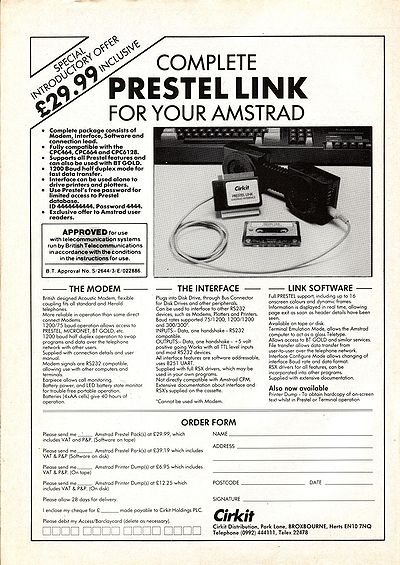Difference between revisions of "Cirkit serial interface"
(→Specs (from advert)) |
|||
| (12 intermediate revisions by 3 users not shown) | |||
| Line 1: | Line 1: | ||
[[Image:Amstrad_Computer_User8512_006.jpg|thumb|400px|right|The Cirkit serial link was used for the Cirkit Prestel link]] | [[Image:Amstrad_Computer_User8512_006.jpg|thumb|400px|right|The Cirkit serial link was used for the Cirkit Prestel link]] | ||
| − | + | The Prestel Link Interface is a serial interface from [[Cirkit]] and [[HoneySoft]], the interface was bundled with a modem (or actually, an acoustic coupler). The interface is mainly intended for being used with that modem. It can be also used as a general purpose RS232 interface, but there are several restrictions: The outputs are TTL levels (which won't work with devices that insist on proper RS232 voltages), only a few baudrates are supported, only RX, TX, RTS, DSR are implemented (no CTS,DTR). | |
| − | * | + | * '''Note''' - Cirkit reportedly also made a "Twin-port" serial interface (which probably used other chipset) |
== Technical == | == Technical == | ||
| − | + | The interface uses only two I/O ports: | |
| − | + | ||
| − | + | Port FADFh - [[8251 USART chip|8251 UART]] Data register | |
| + | Port FBDFh - [[8251 USART chip|8251 UART]] Status/Control register | ||
| + | |||
| + | For details on the I/O ports see [[8251 USART chip]]. For details on the interface see [[Media:Cirkit prestel link hardware.txt|hardware.txt]]. | ||
| + | |||
| + | The baudrates are derived from a 614KHz oscillator, divided by 32 (=19.2KHz), the TX rate can be optionally further divided by 16 (=1200Hz) (this is done by setting the DTR bit, which is misused to latch the baudrate selection, rather than to output a DTR signal), the RX rate doesn't have such an extra divider. Moreover, that rates can be divided by 1, 16, or 64 (inside of the [[8251 USART chip]]. The officially supported RX/TX rates are 1200/1200, 300/300, and 1200/75 baud. Further undocumented rates are 19200/19200, 19200/1200, and 300/18.75 baud (though they may be too slow/fast to be of practical use). | ||
== Pictures == | == Pictures == | ||
| Line 15: | Line 20: | ||
<gallery> | <gallery> | ||
Image:NoPicture.gif|Circuit board, etc. | Image:NoPicture.gif|Circuit board, etc. | ||
| + | Image:Amstrad_Computer_User8512_006.jpg|Advert (ACU, December 1985) | ||
| + | Image:ACU8701062.jpg|Advert (ACU, January 1987) | ||
</gallery> | </gallery> | ||
| + | |||
| + | == Manual == | ||
| + | |||
| + | Documentation is found on the driver cassette (files HARDWARE.DOC and RSX.DOC, which can be viewed or printed with LIST.BAS). Below are the two DOC files converted to TXT format: | ||
| + | |||
| + | * [[Media:Cirkit prestel link hardware.txt]] | ||
| + | * [[Media:Cirkit prestel link rsx.txt]] | ||
== Downloads == | == Downloads == | ||
| − | * | + | * [[Media:CirkitPrestelLinkTapes.ZIP|Cirkit Prestel Link Drivers & Documentation on cassette]] - contains the following files: |
| + | ** MENU.BAS - Prestel Link, Terminal, Send/Receive File tool (versions 1.0a without advert, 1.0a with advert, 1.0b) | ||
| + | ** USER.BIN - RSX Commands 1 (interface) (versions 1.0, 1.2, 1.3) | ||
| + | ** PRES.BIN - RSX Commands 2 (prestel) (versions 1.0, 2.0) | ||
| + | ** LIST.BAS - Tool for viewing/printing the DOC files on Side B (LIST.BAS is not included on the v1.0b tape image) | ||
| + | ** HARDWARE.DOC - Description of the I/O Ports and cable | ||
| + | ** RSX.DOC - Description of the RSX commands (USER.BIN and PRES.BIN) | ||
| + | |||
| + | * [[Media:Cirkit Prestel Link 2.zip]] - version 2 - contains only one file: | ||
| + | ** CPL2 - some kind of terminal software or so | ||
== Specs (from advert) == | == Specs (from advert) == | ||
| + | * Fully compatible with the CPC464, CPC664 and CPC6128. | ||
* Plugs into Disk Drive, through Bus Connector for Disk Drives and other peripherals. <br> ['''Note:''' On the CPC 464, the "Expansion Port" was called "Floppy Port", this is probably what is meant by "into Disk Drive"] <br> ['''Note:''' The photo in advert seems to be a fake. It looks like a 2x28 pin expansion for Sinclair Spectrum, re-badged as Amstrad Interface for the advert] | * Plugs into Disk Drive, through Bus Connector for Disk Drives and other peripherals. <br> ['''Note:''' On the CPC 464, the "Expansion Port" was called "Floppy Port", this is probably what is meant by "into Disk Drive"] <br> ['''Note:''' The photo in advert seems to be a fake. It looks like a 2x28 pin expansion for Sinclair Spectrum, re-badged as Amstrad Interface for the advert] | ||
* Can be used to interface to other RS232 devices, such as Modems, Plotters and Printers. | * Can be used to interface to other RS232 devices, such as Modems, Plotters and Printers. | ||
| Line 33: | Line 57: | ||
* Extensive documentation about interface and RSX's supplied on cassette. | * Extensive documentation about interface and RSX's supplied on cassette. | ||
| − | [[Category: | + | [[Category:Network]] [[Category:Peripherals]] [[Category:Serial_interfaces]] [[Category:Communication Software]] |
Latest revision as of 13:08, 24 February 2018
The Prestel Link Interface is a serial interface from Cirkit and HoneySoft, the interface was bundled with a modem (or actually, an acoustic coupler). The interface is mainly intended for being used with that modem. It can be also used as a general purpose RS232 interface, but there are several restrictions: The outputs are TTL levels (which won't work with devices that insist on proper RS232 voltages), only a few baudrates are supported, only RX, TX, RTS, DSR are implemented (no CTS,DTR).
- Note - Cirkit reportedly also made a "Twin-port" serial interface (which probably used other chipset)
Technical
The interface uses only two I/O ports:
Port FADFh - 8251 UART Data register Port FBDFh - 8251 UART Status/Control register
For details on the I/O ports see 8251 USART chip. For details on the interface see hardware.txt.
The baudrates are derived from a 614KHz oscillator, divided by 32 (=19.2KHz), the TX rate can be optionally further divided by 16 (=1200Hz) (this is done by setting the DTR bit, which is misused to latch the baudrate selection, rather than to output a DTR signal), the RX rate doesn't have such an extra divider. Moreover, that rates can be divided by 1, 16, or 64 (inside of the 8251 USART chip. The officially supported RX/TX rates are 1200/1200, 300/300, and 1200/75 baud. Further undocumented rates are 19200/19200, 19200/1200, and 300/18.75 baud (though they may be too slow/fast to be of practical use).
Pictures
Manual
Documentation is found on the driver cassette (files HARDWARE.DOC and RSX.DOC, which can be viewed or printed with LIST.BAS). Below are the two DOC files converted to TXT format:
Downloads
- Cirkit Prestel Link Drivers & Documentation on cassette - contains the following files:
- MENU.BAS - Prestel Link, Terminal, Send/Receive File tool (versions 1.0a without advert, 1.0a with advert, 1.0b)
- USER.BIN - RSX Commands 1 (interface) (versions 1.0, 1.2, 1.3)
- PRES.BIN - RSX Commands 2 (prestel) (versions 1.0, 2.0)
- LIST.BAS - Tool for viewing/printing the DOC files on Side B (LIST.BAS is not included on the v1.0b tape image)
- HARDWARE.DOC - Description of the I/O Ports and cable
- RSX.DOC - Description of the RSX commands (USER.BIN and PRES.BIN)
- Media:Cirkit Prestel Link 2.zip - version 2 - contains only one file:
- CPL2 - some kind of terminal software or so
Specs (from advert)
- Fully compatible with the CPC464, CPC664 and CPC6128.
- Plugs into Disk Drive, through Bus Connector for Disk Drives and other peripherals.
[Note: On the CPC 464, the "Expansion Port" was called "Floppy Port", this is probably what is meant by "into Disk Drive"]
[Note: The photo in advert seems to be a fake. It looks like a 2x28 pin expansion for Sinclair Spectrum, re-badged as Amstrad Interface for the advert] - Can be used to interface to other RS232 devices, such as Modems, Plotters and Printers.
- Baud rates supported 75/1200, 1200/1200 and 300/300
- INPUTS:- Data, one handshake - RS232 compatible
- OUTPUTS:- Data, one handshake - +5 volt positive going Works with all TTL level inputs and most RS232 devices.
- All interface features are software addressable, uses 8251 UART.
- Supplied with full RSX drivers, which may be used in your own programs.
- Not directly compatible with Amstrad CPM.
- Extensive documentation about interface and RSX's supplied on cassette.



